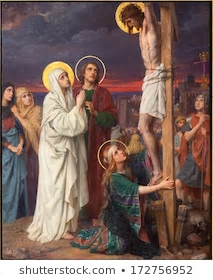Our Lady of Sorrows: the Totality of Christian Discipleship
- Dorianne
- Apr 3, 2020
- 4 min read
Today is a special day in the hearts of devoted Maltese people. The feast of Our Lady of Sorrows is imprinted in many hearts. Yet, this year we have to forgo the usual procession in her honour; however this fasting can be an occasion to bring us even closer to that mystery of suffering because we are all affected by the reality of suffering. We cannot shy away from it. The bombardment of news with the latest ravages of the Covid-19 pandemic brings us to the stark reality of our vulnerability and the various forms of suffering this pandemic is leaving in its wake. Somehow, our isolation can be an opportunity to become more attuned and sensible to the lesson imparted through this vulnerability. It becomes an occasion to look at Our Lady of Sorrows in a deeper light which transcends mere devotion to become our whole way of life!
The poignant moment of Our Lady standing near the cross is the climax of the journey of the Christian disciple par excellence, which started from her immaculate conception, and her free choice in her utterance of the single phrase of collaboration to the grace of God to work in her, in order to become the mother of the God-Man, and thus to freely collaborate with the Divine plan of salvation. Her answer, thus, becomes universal in nature.
Her free choice does not come without its due share of obstacles. She does not become entitled to any earthly privileges but, rather, forgoes even her own plans. She becomes pregnant out of wedlock; she gives birth to the Son of God after an arduous journey and in abject poverty. The prophecy of Simeon warns her of the suffering she must endure. Together with Joseph and her infant son, she has to flee to Egypt in order to escape the wrath of a king bent on annihilating an infant representing an imminent threat to his kingdom. As Jesus leaves home to start his mission in his preaching of the Good News, Mary recedes into the background.
Yet, Mary is the person who is the ideal Christian disciple, bent on moments of reflection. In most times, while earlier we read about Mary as the one who reflects about her circumstances, later Mary's reflection is characterised by her conspicuous absence. She seems to be aware of her role and to step back from playing an active part at times. Yet, she is always present.
Together with the image of the crucified Christ, the image of our Lady of Sorrows becomes central because we can somehow identify with Christ and our Lady in their suffering, as we experience the toil of hardship as part of our lives. Since we have become prey to sin and its effects, we are burdened with its repercussions. Although Christ and his mother (through the grace of God) could not sin, they were impacted by the effects of sin. They did not evade those effects but embraced them. Her suffering becomes inextricably bound to the wholeness of the human being. The Christian embraces the totality of his/her own experiences with both the positive and negative experiences of life. The Good News is not a call to escapism but to live the totality of life in a new light. The Good News gives meaning to the whole human experience and redeems it.
This is why Mary, amid her suffering, was standing near the cross (Jn 19, 25). Pope Francis speaks of this as follows: "And how she bore [the sorrows], how she bore them well, with strength, with tears: it was not a false distress, it was just the heart destroyed by grief." From the cross, Christ says to the beloved disciple, "Here is your mother." Pope Francis tells us that "in the motherhood of Our Lady we see the motherhood of the Church which receives everyone, good and bad: everyone." Hence, Mary's suffering enables her to see beyond the crucifixion into the future. Her motherhood extends to the whole human race.
Christian discipleship does not end with suffering and death. The death of Jesus on the cross is the glorification which lifts up the whole human race and heralds the resurrection. Like Mary we are called to live the here and now in a new totality. The Good News bathes our wholeness (both the beauty and the suffering in life) in a radiant and glorious light. It enables us to live the present oriented towards the future. This does not entail understanding and rationalising our experiences. Mary's privilege to become the mother of God does not earn her the privilege of understanding the reality of life in Christ. The role of the disciple is to thread on the path laid out by Christ, putting the totality of his/her life in every step - living the here and now (with many questions too!!) yet oriented towards the future. In our present suffering in all its forms (we can think of the people at the hospitals, dying separated from their beloved ones, the doctors and the healthcare workers in a race to save lives, the persons who find no consolation in their isolation, and the list goes on) we look up to the Mother of the God-Man and our mother and companion in our journey of faith and hope amidst all tribulations and pray for her counsel and advice. For she has been there before us and can gently nurture us towards the fullness of life in Christ.
Note: The reflections by Pope Francis were taken from the Catholic News Agency:
https://www.catholicnewsagency.com/news/pope-francis-reflect-on-the-seven-sorrows-of-mary-our-mother-16197 [accessed 3 April 2020]






Comments